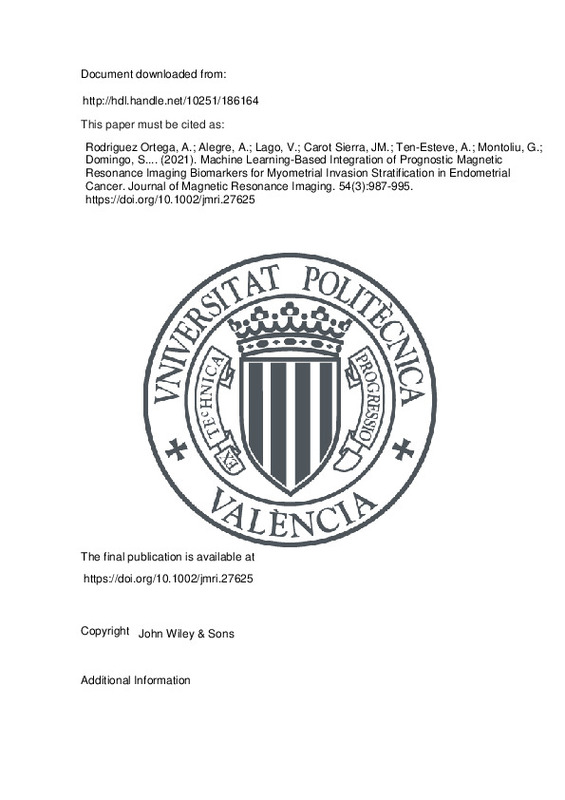JavaScript is disabled for your browser. Some features of this site may not work without it.
Buscar en RiuNet
Listar
Mi cuenta
Estadísticas
Ayuda RiuNet
Admin. UPV
Machine Learning-Based Integration of Prognostic Magnetic Resonance Imaging Biomarkers for Myometrial Invasion Stratification in Endometrial Cancer
Mostrar el registro sencillo del ítem
Ficheros en el ítem
| dc.contributor.author | Rodriguez Ortega, Alejandro
|
es_ES |
| dc.contributor.author | Alegre, Alberto
|
es_ES |
| dc.contributor.author | Lago, Victor
|
es_ES |
| dc.contributor.author | Carot Sierra, José Miguel
|
es_ES |
| dc.contributor.author | Ten-Esteve, Amadeo
|
es_ES |
| dc.contributor.author | Montoliu, Guillermina
|
es_ES |
| dc.contributor.author | Domingo, Santiago
|
es_ES |
| dc.contributor.author | Alberich-Bayarri, Angel
|
es_ES |
| dc.contributor.author | Marti-Bonmati, Luis
|
es_ES |
| dc.date.accessioned | 2022-09-15T18:03:53Z | |
| dc.date.available | 2022-09-15T18:03:53Z | |
| dc.date.issued | 2021-09 | es_ES |
| dc.identifier.issn | 1053-1807 | es_ES |
| dc.identifier.uri | http://hdl.handle.net/10251/186164 | |
| dc.description.abstract | [EN] Background: Estimation of the depth of myometrial invasion (MI) in endometrial cancer is pivotal in the preoperatively staging. Magnetic resonance (MR) reports suffer from human subjectivity. Multiparametric MR imaging radiomics and parameters may improve the diagnostic accuracy. Purpose: To discriminate between patients with MI ¿ 50% using a machine learning-based model combining texture features and descriptors from preoperatively MR images. Study Type: Retrospective. Population: One hundred forty-three women with endometrial cancer were included. The series was split into training (n = 107, 46 with MI ¿ 50%) and test (n = 36, 16 with MI ¿ 50%) cohorts. Field Strength/Sequences: Fast spin echo T2-weighted (T2W), diffusion-weighted (DW), and T1-weighted gradient echo dynamic contrast-enhanced (DCE) sequences were obtained at 1.5 or 3 T magnets. Assessment: Tumors were manually segmented slice-by-slice. Texture metrics were calculated from T2W and ADC map images. Also, the apparent diffusion coefficient (ADC), wash-in slope, wash-out slope, initial area under the curve at 60 sec and at 90 sec, initial slope, time to peak and peak amplitude maps from DCE sequences were obtained as parameters. MR diagnostic models using single-sequence features and a combination of features and parameters from the three sequences were built to estimate MI using Adaboost methods. The pathological depth of MI was used as gold standard. Statistical Test: Area under the receiver operating characteristic curve (AUROC), sensitivity, specificity, accuracy, positive predictive value, negative predictive value, precision and recall were computed to assess the Adaboost models performance. Results: The diagnostic model based on the features and parameters combination showed the best performance to depict patient with MI ¿ 50% in the test cohort (accuracy = 86.1% and AUROC = 87.1%). The rest of diagnostic models showed a worse accuracy (accuracy = 41.67%¿63.89% and AUROC = 41.43%¿63.13%). Data Conclusion: The model combining the texture features from T2W and ADC map images with the semi-quantitative parameters from DW and DCE series allow the preoperative estimation of myometrial invasion. Evidence Level: 4 Technical Efficacy: Stage 3 | es_ES |
| dc.description.sponsorship | This study received funding from the Global Investigator Initiated Research Committee (GIIRC) research program by Bracco S.p.A (2015/0724). The funders had no role in study design, data collection and analysis and preparation of the manuscript. | es_ES |
| dc.language | Inglés | es_ES |
| dc.publisher | John Wiley & Sons | es_ES |
| dc.relation.ispartof | Journal of Magnetic Resonance Imaging | es_ES |
| dc.rights | Reserva de todos los derechos | es_ES |
| dc.subject | Endometrial cancer | es_ES |
| dc.subject | Magnetic resonance | es_ES |
| dc.subject | Radiomics | es_ES |
| dc.subject | Diffusion | es_ES |
| dc.subject | Perfusion | es_ES |
| dc.subject.classification | ESTADISTICA E INVESTIGACION OPERATIVA | es_ES |
| dc.title | Machine Learning-Based Integration of Prognostic Magnetic Resonance Imaging Biomarkers for Myometrial Invasion Stratification in Endometrial Cancer | es_ES |
| dc.type | Artículo | es_ES |
| dc.identifier.doi | 10.1002/jmri.27625 | es_ES |
| dc.relation.projectID | info:eu-repo/grantAgreement/GIIRC//2015%2F0724/ | es_ES |
| dc.rights.accessRights | Abierto | es_ES |
| dc.contributor.affiliation | Universitat Politècnica de València. Departamento de Estadística e Investigación Operativa Aplicadas y Calidad - Departament d'Estadística i Investigació Operativa Aplicades i Qualitat | es_ES |
| dc.contributor.affiliation | Universitat Politècnica de València. Departamento de Ingeniería Gráfica - Departament d'Enginyeria Gràfica | es_ES |
| dc.description.bibliographicCitation | Rodriguez Ortega, A.; Alegre, A.; Lago, V.; Carot Sierra, JM.; Ten-Esteve, A.; Montoliu, G.; Domingo, S.... (2021). Machine Learning-Based Integration of Prognostic Magnetic Resonance Imaging Biomarkers for Myometrial Invasion Stratification in Endometrial Cancer. Journal of Magnetic Resonance Imaging. 54(3):987-995. https://doi.org/10.1002/jmri.27625 | es_ES |
| dc.description.accrualMethod | S | es_ES |
| dc.relation.publisherversion | https://doi.org/10.1002/jmri.27625 | es_ES |
| dc.description.upvformatpinicio | 987 | es_ES |
| dc.description.upvformatpfin | 995 | es_ES |
| dc.type.version | info:eu-repo/semantics/publishedVersion | es_ES |
| dc.description.volume | 54 | es_ES |
| dc.description.issue | 3 | es_ES |
| dc.identifier.pmid | 33793008 | es_ES |
| dc.relation.pasarela | S\432678 | es_ES |
| dc.contributor.funder | Global Investigator Initiated Research Committee | es_ES |







![[Cerrado]](/themes/UPV/images/candado.png)

